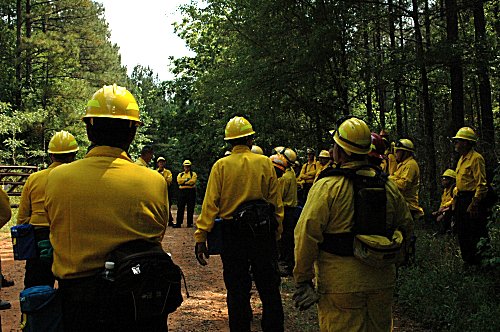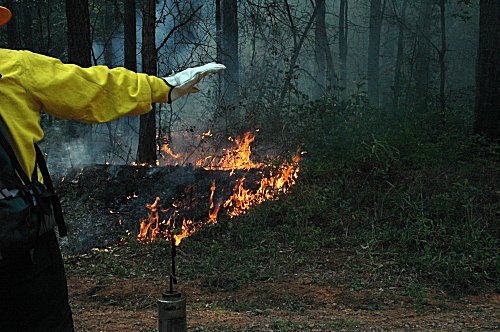Wildland Firefighting Training
This was the first of two weekends for this course hosted by Wolfskin VFD.
On Saturday the 40 of us from at least seven Oglethorpe County VFDs met for a more-than-full day of indoor classtime. The five instructors are Georgia Forestry Commission firefighters. There are eleven of us from Wolfskin, a great showing but we miss all the folks who weren't able to make it.
Saturday we got there at 8am, and at noon broke for a short lunch. Someone asked the instructor when the day would be over and he said “8pm”. HUH??? We had all been assuming we’d be out at 5pm and thought it was a joke. Well, it turned out it wasn’t a joke, and it won’t be a joke tomorrow or next Saturday either!
Saturday's sessions covered wildland fire characteristics and, of some interest the ICS, the Incident Command System. This is a kind of a unique system of dynamic organization in which strategy and tactics are communicated through a hierarchy from the Incident Commander to the lowest of the lows, the grunts on the ground (us).
The Incident Command System is being used universally (meaning all US States use the same system), apparently because it works so well. You can have volunteers sent in to a situation from Maine, Alaska, Florida, and Ohio, and they can all work together because they all speak this language. In developing situations, which need not be firefighting but could be hurricane relief, as in Katrina, or any other situation, as in giving a party, you often have a few individuals arriving first at the scene followed by many more over the next time periods. That is what this system is designed to accomodate. This is my understanding, at least.
So we are squad members, and there will be four squads. There are 40 firefighters from at least seven Oglethorpe County volunteer fire departments, and of course when we walked into class today each department sat together. So it was rather clever that one of the first things they did was to have us count off 1-4 to assign us to the four different squads of ten each. That mixes us together.
Sunday was another 12-hour day. We spent the first couple of hours in-class on safety zones (marked places you can retreat to through an escape route should a wildland fire suddenly change behavior) and entrapment (what happens if your escape route gets cut off and you can't get to the safety zone). And then we went outside and practiced on getting into our fire shelters. All wildland firefighters have to carry these things now. The bottom right photo in the above link shows what these things look like.
They're tightly packaged and are basically aluminum coated bodybags with a slit down the length. You shake them out, step into them, then get down on the ground with the shelter covering you. The aluminum reflects 95% of heat radiation and allows you to breathe cool air from the ground until the fire has passed over. You might emerge with third degree burns but in many cases emerge alive.
So we had to shake out the things and get into them and covered over properly in 25 seconds to pass this exercise. Glenn had a bit of trouble because of the MS, but his squad leader worked diligently and they found a way he could get into the thing without relying too much on the legs, and he passed the exercise too.
Then we had lunch and proceeded to the burn sites on Blacksnake Road that runs above Goulding Creek on the other side of the Sparkle. Here we were going to spend an hour as squads making a scratch line, a cleared 3-foot path surrounding the burn site, and then start fires. Here we are receiving instructions (and by the way, the the blue boxes you see hanging from the belts of everyone in the photo Glenn took are the fire shelters).
Note the pretty yellow shirts and green pants. Although many of the Oglethorpe County ffs are experienced in structure fires (for which you wear a completely different outfit) and have fought wildland fires, many had not been really trained or prepared for that. Everyone who took the course had to buy the clothing and a few other items, so that's why we all look the same.
Even though the temperature was 85 deg, direct sun, 24% humidity they were extremely comfortable. I'd like a wardrobe of them, frankly.

We all got our tools and keeping proper ten foot distance advanced in four lines of ten folks each in cleverly arranged formats to get the scratch line completed in short order.
Then we set the fires using the clever drip torch you see in the photo below.

Unfortunately this area was still too moist and did not burn well. After an hour or so of effort we had a discussion about how everything worked and did not work and then voted on trying a burn at a second site. The vote was 20:19 in favor (a lot of people really wanted to go home early), so the instructors proceeded up the hill and began spotting fires in a preplanned area. Then we were called up one squad at a time to put it out.
This fire burned MUCH more successfully, and our approach was to contain it by quickly clearing a fire line around it, concentrating particularly on zones where the fire was headed most rapidly. Things went very well indeed and within three hours we had the fire completely contained and let it burn itself out.
That practice burn and fire line creation was extremely grueling. Neither of us are going to have a treadmill cardiac exam for awhile. I have to say the five instructors, who double as squad leaders and Incident Commander, are fantastic. They're enthusiastic about what they're doing, extremely patient with us, make sure everyone is doing everything right, and clearly love what they're doing.
We finished up at 8pm, and as we were going over the second burn the folks from Beaverdam VFD got a dispatch for a fire in their area and off they went, running for their trucks.
And that's half the course - we'll complete the remainder next weekend.



0 Comments:
Post a Comment
<< Home